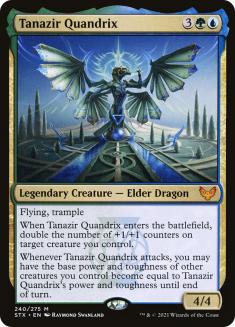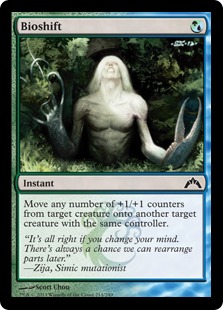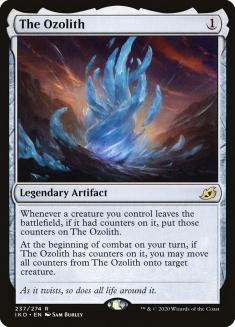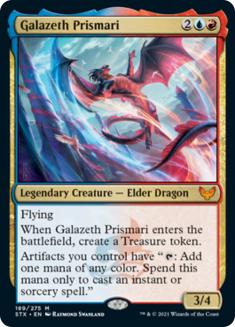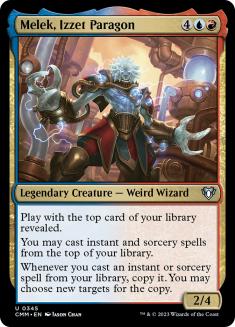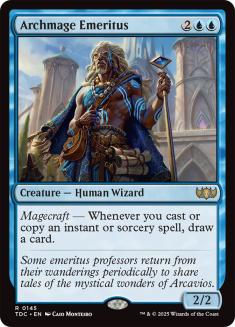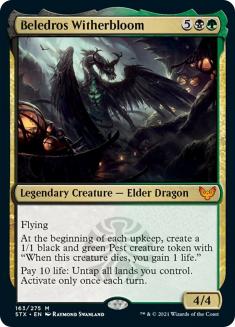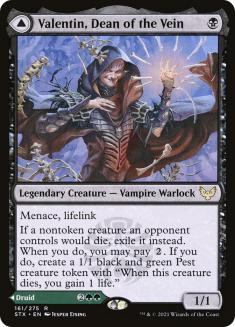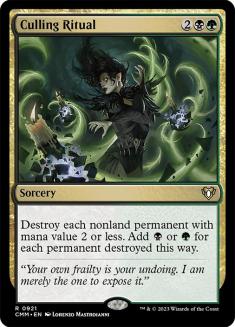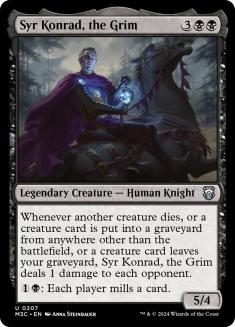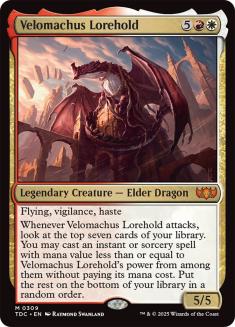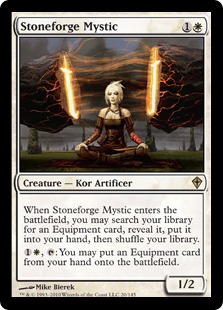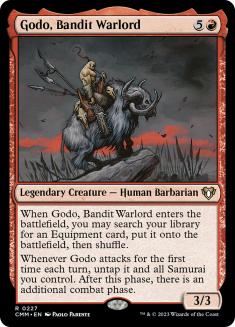The format was originally named after them. Mention of their kind breeds terror in the minds of Commander players everywhere. One of their kind has become a primary villain in the Magic storyline. Elder Dragons have returned in Strixhaven. Although they don’t bear much resemblance to their ancient progenitors, their powers cannot be denied.
As founders of the school’s colleges, each of them has a build-around feel, but there are also innovative ways to approach assembling a deck with our draconic friends. Last time, I explored Shadrix Silverquill in my discussion of that college. This time, I’ll engage in some ideas about where you might take the other four.
Tanazir Quandrix
For the rest of my days, the reason to play any Simic deck is so that I can slam out Body of Research. It’s not like you’ll need Tanazir to double up that Fractal’s counters, but it’ll be hilarious anyway. Just watch out for now nearly-forgotten cards like Phthisis or one of my favorite hidden gems — Backlash.
The obvious path for Tanazir is to go with tried-and-true “counters matter” strategies. I could replace Prime Speaker Zegana with Tanazir in my Zegana and a Dice Bag deck. Dust off your Doubling Season, Master Biomancer, and Metallic Mimic and go to town with your favorite applicable creatures.
I’d want to find something a little less obvious for Tanazir. It’d be silly to ignore his abilities, but you can focus on the latter of them, which might get lost when you’re looking at the former. With a swarm of smaller creatures, Tanazir can get kind of deadly in short order. If you go with a Voltron kind of theme, you don’t need that big of an army to be deadly. A card like Craterhoof Behemoth is certain to be overkill, but Overwhelming Stampede is a nicely costed option. Even without counters and a creature larger than Tanazir, your other creatures will have a base power and toughness of 8/8, and then still get the +4/+4 from the Overwhelming Stampede. You don’t need all that many creatures to take out someone.
You’ll still want to add in some cards that play nicely with counters. Forgotten Ancient is a favorite. You can use it to spread those counters around or just pile them up onto Tanazir. An underplayed and underappreciated counters card is Bioshift. It’s an instant, so you can ship counters after blockers have been declared for a lethal strike. Bioshift also says that you can move any number of them, so you might only take half the counters off that Body of Research Fractal. Of course, you can always just move the counters with Tanazir’s combat trigger on the stack, effectively sharing them with the team. And I probably don’t need to tell you how silly The Ozolith can be with Tanazir.
The final piece is some evasion, whether that’s protection from colors, like with Sword of Fire and Ice or Sword of Light and Shadow (which both make Tanazir larger); the activated ability of Thassa, God of the Sea or Rogue’s Passage; or one of my favorites — Sun Quan, Lord of Wu. If you need more than one swing to take folks out, keeping Tanazir safe will ensure that he’s around for another combat.
If you want to go way outside the box and gamble a little in an environment where you know that other players are going to have lots of creatures with +1/+1 counters, run Tanazir as Clone tribal. Start with Altered Ego, which you can have enter the battlefield with counters on it, add Double Major, and go from there. Instead of relying on creatures that natively have counters, use sorceries or instants that add them, like Biogenic Upgrade or Strength of the Pack. You’ll get to copy the best creatures on the battlefield and then make them better.
Galazeth Prismari
My concern with Galazeth Prismari is that it leads you strongly in the direction that the Prismari Performance deck already does. To be fair, there are some cool battlecruiser choices in the deck, like Swarm Intelligence and Octavia, Living Thesis.
Although Galazeth might force you in the direction of casting and creating artifacts that help fuel your big instants and sorceries, the path for you to find is in the choices that excite you. Whether the artifacts you create are the somewhat obvious Treasures or the less-common Servos and Thopters, you have some room.
You can look to the Izzet planeswalkers for some options. Saheeli, Sublime Artificer creates a Servo every time you cast a noncreature spell. Saheeli, the Gifted creates one with her first +1 ability. Her second will provide you with a big mana discount for that spell you’re itching to cast. Ral, Storm Conduit provides a little damage for casting or copying instants and sorceries, but it really shows its colors when you start casting those big spells, using its -2 ability to copy them.
He’s a little old-school, but Melek, Izzet Paragon is going to be nuts, especially with some top-of-the-library control, like Scroll Rack. Speaking of old school, Niv-Mizzet, the Firemind is going to draw cards for you and deal some damage along the way. Add Archmage Emeritus on top of that and you’ll keep your hand full while dealing even more damage. Since you’re magecrafting it, add Wandering Archaic for more fun.
The elephant in the room regarding a Galazeth deck is Hullbreacher. Yes, running Hullbreacher with wheels is effective at helping you dominate a game, even more so with Galazeth since you don’t have to sacrifice the Treasures. It’s not likely to make you that many friends. Still, I’m of the opinion that Hullbreacher can be played fairly. It’s effective at keeping people from being too greedy with card draw, which is healthy for the game overall. The simple message here is that if you’re going to play Hullbreacher, please read the room.
Clue tokens might be a way to go. You then have the option of using them for mana or drawing cards. Since you’re casting instants and sorceries, Trail of Evidence is good. There’s also Tamiyo’s Journal that keeps pumping them out. Magnifying Glass is a mana rock that with Galazeth can tap for colored mana or investigate. Daring Sleuth will transform into Bearer of Overwhelming Truths and give you Clues for dealing combat damage. Having prowess suggests playing some instants and sorceries that buff it.
A somewhat old-school token direction is Myr. Myr Battlesphere can get dangerous in a hurry, or if you don’t have an attack vector yet, those Myr will fuel your spells. Brudiclad, Telchor Engineer pumps out Myr tokens and gives you options on what your tokens become. Myr Matrix doesn’t tap to activate, so you can tap it as a mana source; add Training Grounds to make those Myr even cheaper to create. Genesis Chamber is interesting if you’re playing some nontoken creatures as well. It only triggers if it’s untapped, so you can tap it for mana on your turn after you’re done with it, turning it off for other players.
I’ll offer you one more unusual artifact token option: Toggo, Goblin Weaponsmith. Good old rock. Nothing beats that.
Beledros Witherbloom
The Witherbloom Witchcraft deck looks pretty solid right out of the box. Pests are swarming all around, and it would be easy to replace Willowdusk, Essence Seer with Beledros as the commander. The upgrade path wouldn’t take much. One of my favorite cards, the underappreciated Sangromancer, is already in the deck. Its presence will quickly mitigate the life loss from untapping all your lands with Beledros.
Valentin, Dean of the Vein is the first replacement to go in. Even if you’re not creating lots of Pests, the fact that it exiles your opponents’ creatures is big money in Commander. Culling Ritual is upgrade number two. You’ll be surprised by how much stuff it’ll catch, even if other players aren’t running token strategies; if they are, you’ll have lots of fuel. The deck is already about making life out of death, meaning lots of creatures will be hitting the graveyard. Syr Konrad, the Grim is a natural choice to take advantage of all that, which leads you to additionally obvious choices of Blood Artist and Zulaport Cutthroat.
Finding the unusual build of Beledros is going to take some work. You won’t have much trouble generating the mana to cast her, since green and black are the best at ramping and acceleration. The question then is what to do with her ability to untap lands, assuming you don’t want to just drain away all your life and cast Repay in Kind.
The first set of cards that go into the deck are the ones that copy an activated ability. This includes Lithoform Engine, Illusionist’s Bracers, and Rings of Brighthearth. There’s no real bomb combo here, since we can only activate Beledros once, but we can get another copy by untapping Lithoform Engine with Voltaic Key. Side tip/different deck: You can go infinite if you’re also playing blue by adding Minamo, School at Water’s Edge.
Even without going infinite, that’s a good deal of mana. Exsanguinate is an excellent option, getting back more than we lost in the activation. Genesis Wave will also get you there. A little more janky, try Garruk’s Packleader or Elemental Bond along with some beefy creatures, to include Kodama of the East Tree. Resolve something big; Kodama and Packleader both trigger. You draw a card, put something from your hand onto the battlefield, and potentially draw another card, which you can then cast. You can probably run through several iterations before you’ve run out of mana.
You don’t need to go full Blood-Bond combo to get value out of Vito, Thorn of the Dusk Rose. Those Pests you get each upkeep (that’s four per turn cycle) are going to pile up. At some point, you can attack with them and activate Vito to give them all lifelink, putting someone in a pretty awkward position.
Velomachus Lorehold
Lorehold is a new look into what are traditionally the colors of nothing but combat. Its founder is part of that revolution, but not quite as removed as you might think. Velomachus still needs to get into the red zone, but that’s just the beginning with this monster. This is the most wide-open of the four; you really do get to build to your tastes here, and there isn’t a particularly obvious direction (besides having to attack).
You’ll want to focus on instants and sorceries that cost five or less, even if you’ll later beef up Velomachus. Extra combat step cards like World at War, Relentless Assault, Waves of Aggression, and Savage Beating go right to the top of the list. Akroma’s Will makes the cut in nearly any white deck, and will make sure that Velomachus lives to battle again (while piling up the damage and the lifegain).
You might want to consider a few specific sweepers, like Divine Reckoning, Slash the Ranks, or Tragic Arrogance. Lorehold Command fits the converted mana cost and gives you plenty of options. While you want to take advantage of casting bigger things, Velomachus will also cast your targeted removal, like Swords to Plowshares and Path to Exile. Since you’re making all those combat steps we talked about earlier, Iroas, Goad of Victory makes things awkward for your opponents. It will also protect your team if you want to cast damage spells like Chain Reaction or Hour of Devastation off the trigger.
Velomachus Voltron isn’t outside the possibilities, since you’re in the colors of both Stoneforge Mystic and Godo, Bandit Warlord. Commander’s Plate is a great place to start; then pull out some of your other favorites. Argentum Armor will make Velomachus a two-shot killer. Sword of Feast and Famine will help fuel whatever other tomfoolery you want to engage in.
Outside of Leonin Lightscribe and Storm-Kiln Artist, there aren’t any good magecraft options, unless you want to go Spirit tribal with Lorehold Apprentice. Benevolent Offering is a nice political card that’ll get you going in the right direction, Spirit-wise. In fact, it’s an interesting road to go down.
There are quite a few more Spirits than you might realize. Balefire Liege is one of them. So are Karmic Guide, Malignus, Myojin of Cleansing Fire, Selfless Spirit, Skyclave Apparition, Wall of Reverence, and Yosei, the Morning Star. Figure of Destiny can eventually become a Spirit. Returned Pastcaller goes particularly well with Velomachus. Angel of Flight Alabaster gets back your Spirits which have died. Hallowed Spiritkeeper will help you rebuild after a sweeper. There’s plenty of room to build here, and I’ve put it on to the list of things that I’m going to give more serious consideration.
As there are plenty of new Lorehold cards that like to do things with the graveyard (like Quintorius, Field Historian and Reconstruct History), you might consider using Velomachus to help fill it up. You can cast Wheel of Fortune off the trigger, and any number of cards that rummage. You can focus on artifacts and use Scrap Mastery to bring them all back onto the battlefield, or if you make Velomachus a little bigger, Open the Vaults.
From Commander’s very beginnings, to Dragons of Tarkir, and through the reappearance of the originals in new forms in Magic 2019, Elder Dragons have occupied a special place in the format. The five new ones from Strixhaven are more than capable of taking an honored place beside their mighty cousins.
Visit my Decklist Database to see my Signature Decks, the Chromatic Project, and more!


